Proteomic-based identification of haptoglobin-1 precursor as a novel circulating biomarker of ovarian cancer
- PMID: 15199385
- PMCID: PMC2364749
- DOI: 10.1038/sj.bjc.6601882
Proteomic-based identification of haptoglobin-1 precursor as a novel circulating biomarker of ovarian cancer
Abstract
Screening for specific biomarkers of early-stage detection of ovarian cancer is a major health priority due to the asymptomatic nature and poor survival characteristic of the disease. We utilised two-dimensional gel electrophoresis (2DE) to identify differentially expressed proteins in the serum of ovarian cancer patients that may be useful as biomarkers of this disease. In this study, 38 ovarian cancer patients at different pathological grades (grade 1 (n=6), grade 2 (n=8) and grade 3 (n=24)) were compared to a control group of eight healthy women. Serum samples were treated with a mixture of Affigel-Blue and protein A (5 : 1) for 1 h to remove high abundance protein (e.g. immunoglobulin and albumin) and were displayed using 11 cm, pH 4-7 isoelectric focusing strips for the first dimension and 10% acrylamide gel electrophoresis for the second dimension. Protein spots were visualised by SYPRO-Ruby staining, imaged by FX-imager and compared and analysed by PDQuest software. A total of 24 serum proteins were differentially expressed in grade 1 (P<0.05), 31 in grade 2 (P<0.05) and 25 in grade 3 (P<0.05) ovarian cancer patients. Six of the protein spots that were significantly upregulated in all groups of ovarian cancer patients were identified by nano-electrospray quadrupole quadrupole time-of-flight mass spectrometry (n-ESIQ(q)TOFMS) and matrix-assisted laser desorption ionisation time-of-flight mass spectrometry (MALDI-TOFMS) as isoforms of haptoglobin-1 precursor (HAP1), a liver glycoprotein present in human serum. Further identification of the spots at different pathological grades was confirmed by Western blotting using monoclonal antibody against a haptoglobin epitope contained within HAP1. Immunohistochemical localisation of HAP1-like activity was present in malignant ovarian epithelium and stroma but strong immunostaining was present in blood vessels, areas with myxomatous stroma and vascular spaces. No tissue localisation of HAP1-like immunoreactivity was observed in normal ovarian surface epithelium. These data highlight the need to assess circulating concentration of HAP1 in the serum of ovarian cancer patients and evaluate its potential as a biomarker in the early diagnosis of ovarian cancer.
Figures
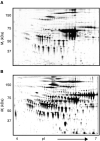
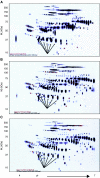
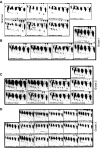
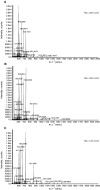

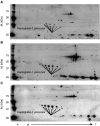

Similar articles
-
Proteomic tracking of serum protein isoforms as screening biomarkers of ovarian cancer.Proteomics. 2005 Nov;5(17):4625-36. doi: 10.1002/pmic.200401321. Proteomics. 2005. PMID: 16220531
-
Proteomic identification of fucosylated haptoglobin alpha isoforms in ascitic fluids and its localization in ovarian carcinoma tissues from Mexican patients.J Ovarian Res. 2014 Feb 27;7:27. doi: 10.1186/1757-2215-7-27. J Ovarian Res. 2014. PMID: 24576319 Free PMC article.
-
Identification of ovarian cancer-associated proteins in symptomatic women: A novel method for semi-quantitative plasma proteomics.Proteomics Clin Appl. 2012 Apr;6(3-4):170-81. doi: 10.1002/prca.201100008. Proteomics Clin Appl. 2012. PMID: 22532453
-
[Analysis of serum biomarkers of ovarian epithelial cancers based on 2-DE DIGE and MALDI TOF/TOF].Zhonghua Zhong Liu Za Zhi. 2008 Oct;30(10):754-8. Zhonghua Zhong Liu Za Zhi. 2008. PMID: 19173805 Chinese.
-
Proteomics-based identification of alpha1-antitrypsin and haptoglobin precursors as novel serum markers in infiltrating ductal breast carcinomas.Clin Chim Acta. 2009 Jun 27;404(2):111-8. doi: 10.1016/j.cca.2009.03.033. Epub 2009 Mar 21. Clin Chim Acta. 2009. PMID: 19306859
Cited by
-
Methodology and applications of disease biomarker identification in human serum.Biomark Insights. 2007 Feb 14;2:21-43. Biomark Insights. 2007. PMID: 19662190 Free PMC article.
-
Human body fluid proteome analysis.Proteomics. 2006 Dec;6(23):6326-53. doi: 10.1002/pmic.200600284. Proteomics. 2006. PMID: 17083142 Free PMC article. Review.
-
What Room for Two-Dimensional Gel-Based Proteomics in a Shotgun Proteomics World?Proteomes. 2020 Aug 6;8(3):17. doi: 10.3390/proteomes8030017. Proteomes. 2020. PMID: 32781532 Free PMC article. Review.
-
Screening and detection of portal vein tumor thrombi-associated serum low molecular weight protein biomarkers in human hepatocellular carcinoma.J Cancer Res Clin Oncol. 2008 Mar;134(3):299-305. doi: 10.1007/s00432-007-0236-7. Epub 2007 Sep 8. J Cancer Res Clin Oncol. 2008. PMID: 17828420 Free PMC article.
-
Identification of host-immune response protein candidates in the sera of human oral squamous cell carcinoma patients.PLoS One. 2014 Oct 1;9(10):e109012. doi: 10.1371/journal.pone.0109012. eCollection 2014. PLoS One. 2014. PMID: 25272005 Free PMC article.
References
-
- Ahmed N, Barker G, Oliva K, Garfin D, Talmadge K, Georgiou H, Quinn M, Rice G (2003) An approach to remove albumin for the proteomic analysis of low abundance biomarkers in human serum. Proteomics 3: 1980–1987 - PubMed
-
- Bastani B, Chu N (1995) Serum CA-125 level in end-stage renal disease patients maintained on chronic peritoneal dialysis or hemodialysis: the effect of continuous presence of peritoneal fluid, peritonitis, and peritoneal catheter implantation. Am J Nephrol 15: 468–472 - PubMed
-
- Beutler E, Gelbart T, Lee P (2002) Haptoglobin polymorphism and iron homeostasis. Clin Chem 48: 2232–2235 - PubMed
-
- Cannistra SA (1993) Cancer of the ovary. N Engl J Med 329: 1550–1559 - PubMed
-
- Devarbhavi H, Kaese D, Williams AW, Rakela J, Klee GG, Kamath PS (2002) Cancer antigen 125 in patients with chronic liver disease. Mayo Clin Proc 77: 538–541 - PubMed
Publication types
MeSH terms
Substances
LinkOut - more resources
Full Text Sources
Other Literature Sources
Medical
Research Materials
Miscellaneous

